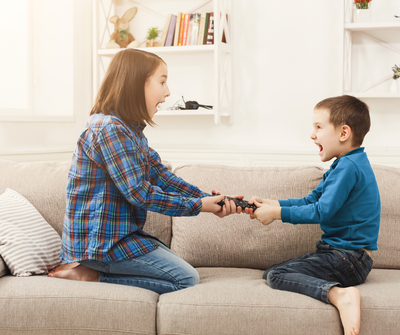How To Resolve Sibling Squabbles
Siblings have plenty of positive lessons, such as problem solving, becoming resilient, sharing and empathy, to practice, but the occasional (or constant) flare-up still may occur.

As with most relationships, building a good foundation is key. Children need to feel loved, wanted, capable and deeply connected to their parents or primary caregivers. This groundwork leads children to the skills and confidence they need to have other positive, loving relationships.
In their timeless book, “Siblings Without Rivalry: How to Help Your Children Live Together So You Can Live Too,” Adele Faber and Elaine Mazlish explain that all of the things one needs to survive and thrive come from parents or other loving adults. Those things include food, clothing, shelter, love, individual time, etc., and when more children are added to the mix, less is available for each of them. The premise is that jealousy blooms and children “fight” literally and figuratively for more of all of those things.
Spending individual time with each child may be more of a difficulty right now than ever before. Can you creatively carve out a segment of time to spend with each child each day? Think chores. Will one child help with dishes just to get some alone time at the kitchen sink with you? Can a younger sibling read the little ones to sleep so you have time to spend with an older child?
The authors caution us to resist the urge to compare children favorably or unfavorably because this can build competition or resentment. Also, do not cast children into a role. If you are told you are a bully long enough, you may become one. Help children see themselves in their best light and that is who they will be more often.
One tried and true method is to acknowledge your child’s emotions with feeling words. When a child races into the room to report angrily a sibling ate the last piece of cake, try:
- “You sound angry” for young children, or for older kids, say, “You sound irate!” Oftentimes, that is all that may be needed; children want to be heard, understood and validated.
- Helping them verbalize their wishes: “You wish she would have saved some cake for you to enjoy, too.”
- Throwing out a possible solution: “How would you feel about helping me bake something?”
But what if a fight breaks out? Faber and Mazlish suggest you let bickering play itself out as an important lesson in conflict resolution, a valuable life skill. If things get a little more intense, help your children out by describing the situation and feelings, without judgment. Tell them you are certain they can work the situation out fairly and reasonably, and walk away. For physical fighting, stop any real fights and send the children to new physical activities in opposite directions to cool off before trying to problem solve.
- Problem solving involves a meeting. Go over ground rules, such as taking turns talking and listening.
- Write down each person’s thoughts and feelings without judgment.
- Together, determine the real problem.
- Take turns naming solutions and write them all out so everyone can see them - all of them.
- Cross out any that are not agreed to by all parties, including parents (save the list).
- Choose an idea to try. Write it out and post it where family members can see the plan. Check back in a day or two to see if the plan is working. If not, choose another idea from your list.
- Help children learn and practice problem solving steps so they eventually can manage them with little or no guidance.
Kim Bushaw, NDSU Extension family science specialist